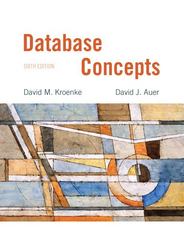Write a set of SQL statements (Hint: Use the SQL ALTER TABLE command.) to add a FullFeePaid
Question:
Write a set of SQL statements (Hint: Use the SQL ALTER TABLE command.) to add a FullFeePaid column to ENROLLMENT and populate the column, assum- ing that the column is NULL. The only possible values for this column are Yes and No. (Compare COURSE.Fee to ENROLLMENT.Amount Paid to determine data values.)
The following is a set of tables for the Art Course database shown in Figure 1-10. For the data for these tables, use the data shown in Figure 1-10. where: CUSTOMER (CustomerNumber, Customer LastName. CustomerFirstName. Phone) COURSE (CourseNumber. Course, CourseDate. Fee) ENROLLMENT (CustomerNumber, Course Number, Amount Paid! CustomerNumber in ENROLLMENT must exist in CustomerNumber in CUSTOMER onal ENROLLMENT must exist in CourseNumber in COURSE. CustomerNumber and CourseNumber are surrogate keys. Therefore, these numbers will never be modified, and there is no need for cascading updates. No customer data are ever deleted, so there is no need to cascade deletions. Courses can be deleted. If there are enrollment entries for a deleted class, they should also be deleted.
These tables, referential integrity constraints, and data are used as the basis for the SQL statements you will create in the exercises that follow. If possible, run these statements in an actual DBMS, as appropriate, to obtain results. Name your database ART_COURSE_.
DATABASE. For each SQL statement you write, show the results based on these data. Use data types consistent with the DBMS you are using. If you are not using an actual DBMS, consistently represent data types using either the SQL Server, Oracle Database, or MySQL data types shown in Figure 3-4.AppendixLO1
Step by Step Answer:






